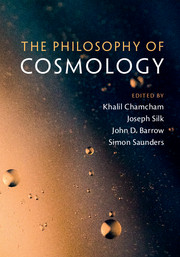Book contents
- Frontmatter
- Contents
- List of Contributors
- Preface
- Acknowledgments
- Part I Issues in the Philosophy of Cosmology
- Part II Structures in the Universe and the Structure of Modern Cosmology
- Part III Foundations of Cosmology: Gravity and the Quantum
- Part IV Quantum Foundations and Quantum Gravity
- Part V Methodological and Philosophical Issues
- 19 Limits of Time in Cosmology
- 20 Self-Locating Priors and Cosmological Measures
- 21 On Probability and Cosmology: Inference Beyond Data?
- 22 Testing the Multiverse: Bayes, Fine-Tuning and Typicality
- 23 A New Perspective on Einstein's Philosophy of Cosmology
- 24 The Nature of the Past Hypothesis
- 25 Big and Small
- Index
- References
24 - The Nature of the Past Hypothesis
from Part V - Methodological and Philosophical Issues
Published online by Cambridge University Press: 18 April 2017
- Frontmatter
- Contents
- List of Contributors
- Preface
- Acknowledgments
- Part I Issues in the Philosophy of Cosmology
- Part II Structures in the Universe and the Structure of Modern Cosmology
- Part III Foundations of Cosmology: Gravity and the Quantum
- Part IV Quantum Foundations and Quantum Gravity
- Part V Methodological and Philosophical Issues
- 19 Limits of Time in Cosmology
- 20 Self-Locating Priors and Cosmological Measures
- 21 On Probability and Cosmology: Inference Beyond Data?
- 22 Testing the Multiverse: Bayes, Fine-Tuning and Typicality
- 23 A New Perspective on Einstein's Philosophy of Cosmology
- 24 The Nature of the Past Hypothesis
- 25 Big and Small
- Index
- References
Summary
There is a narrative about the nature of asymmetry in time which can be caricatured like this. Firstly, there is our fundamental physics – if we are being really careful about it, this is the standard model or our preferred post-standard-model physics; in reality, in the practical cases we think about, it is more likely to be ordinary quantum mechanics or maybe even classical Hamiltonian dynamics. In any case, it is supposed to be the physics of the microconstituents of the world. And it is time-reversal invariant and shows no particular direction of time.
And secondly there is the observed world, which is full of various kinds of observed asymmetries: dynamical asymmetries, entropic asymmetries, causal, psychological asymmetries, and so on. And the general way we set the problem up is as a contradiction between what our physics says, which is that the world is time-reversal invariant, and what we see around us, which is not time-reversal invariant.
I want to suggest the advantages of a slightly more nuanced way of thinking about the problem. It is really not the case that all of physics, or even most of physics, or even very much of physics, frankly, is “fundamental” physics. In the middle – between the fundamental physics at the bottom, and the directly observed macro-world at the top – we have a huge range of what we might call higher-level (or “emergent”) dynamical systems, governed by higher-level dynamical equations. I am thinking of the equations of fluid dynamics; I am thinking of the Boltzmann equation that governs dilute gases and many similar systems; I am thinking of the Langevin equation and the Fokker–Planck equation that govern Brownian motion; I am thinking of the equations of radioactive decay. (In principle I am also thinking about all the various equations and rules of the higher sciences, but we can confine our attention here just to the panoply of different systems and different equations that we study in physics.)
Actual physics is a plethora of different dynamical systems governed by different sorts of laws. And if you look at those higher-level laws you find – not universally, but very frequently – that they have a whole range of properties which are not shared by the fundamental physics. I want to focus on two particular properties like this.
- Type
- Chapter
- Information
- The Philosophy of Cosmology , pp. 486 - 499Publisher: Cambridge University PressPrint publication year: 2017
References
- 2
- Cited by



